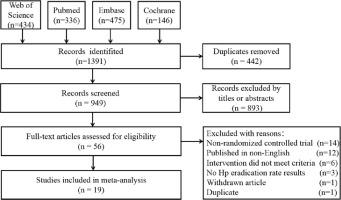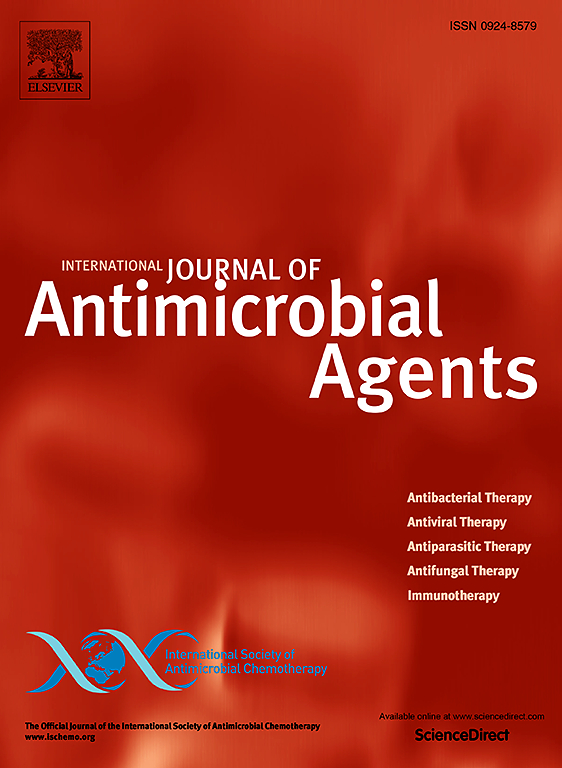The impact of probiotics on Helicobacter pylori eradication with bismuth quadruple therapy: A systematic review and meta-analysis
IF 4.6
2区 医学
Q1 INFECTIOUS DISEASES
International Journal of Antimicrobial Agents
Pub Date : 2025-08-25
DOI:10.1016/j.ijantimicag.2025.107600
引用次数: 0
Abstract
Background
Bismuth quadruple therapy (BQT) remains a cornerstone of first-line Helicobacter pylori eradication. However, its efficacy is increasingly undermined by antibiotic resistance, while frequent adverse events reduce its tolerability. Probiotics have been proposed as adjunctive agents to improve eradication outcomes and mitigate side effects, though their specific role in combination with BQT has yet to be fully established.
Methods
We conducted an extensive search of PubMed, Embase, Web of Science, and Cochrane Library for randomized controlled trials (RCTs) published through November 2024. Eligible studies compared H. pylori eradication rates and adverse events between probiotic-supplemented BQT (PBQT) and standard BQT in infected patients.
Results
Nineteen randomized controlled trials with 2973 samples were included. PBQT significantly improved H. pylori eradication rates compared to BQT alone (pooled odds ratio [OR] = 1.49, 95% confidence interval [CI] 1.20–1.85; P = 0.0004), with low heterogeneity (I² = 0%). Subgroup analyses demonstrated that both Saccharomyces boulardii (OR = 1.62; P < 0.05) and multi-strain probiotics (OR = 1.66; P < 0.05) significantly enhanced eradication rates. Concomitant administration of probiotics with antibiotics also yielded significant benefits (OR = 1.48, 95% CI 1.14–1.92; P = 0.003). PBQT demonstrated superior efficacy in the initial-treatment subgroup (OR = 1.48; P = 0.003) and among patients aged ≥18 y (OR = 1.47; P = 0.005). Regional subgroup analysis revealed a significant improvement in eradication rates for studies conducted in East Asia (OR = 1.66; P = 0.003). Antibiotic-specific subgroup analysis indicated a significant benefit of probiotics in the amoxicillin-clarithromycin BQT subgroup (OR = 1.59; P = 0.01). Overall, adverse events were significantly lower in the PBQT group (OR = 0.44, 95% CI 0.27–0.70, P = 0.0006), especially diarrhoea (OR = 0.33, 95% CI 0.21–0.52, P < 0.00001) and nausea (OR = 0.29, 95% CI 0.11–0.79, P = 0.02).
Conclusions
Adding probiotics, particularly S. boulardii or multi-strain combinations, to BQT significantly improves eradication efficacy and decreases treatment-related adverse events. PBQT represents a pragmatic optimization of current first-line regimens and supports its incorporation into clinical practice to improve H. pylori treatment outcomes.

益生菌对铋四联疗法根除幽门螺杆菌的影响:系统综述和荟萃分析。
背景:铋四联疗法(BQT)仍然是一线根除幽门螺杆菌的基石。然而,其疗效越来越受到抗生素耐药性的影响,而频繁的不良事件降低了其耐受性。虽然益生菌与BQT联合使用的具体作用尚未完全确定,但益生菌已被认为是改善根除结果和减轻副作用的辅助药物。方法:我们对PubMed、Embase、Web of Science和Cochrane Library进行了广泛的检索,检索截至2024年11月发表的随机对照试验(rct)。符合条件的研究比较了感染患者中益生菌补充BQT (PBQT)和标准BQT之间的幽门螺杆菌根除率和不良事件。结果:共纳入19项随机对照试验(RCTs),共2973例样本。益生菌补充铋四联疗法(PBQT)与单独铋四联疗法(BQT)相比,显著提高幽门螺杆菌根除率(合并OR = 1.49,95% CI 1.20-1.85; P = 0.0004),异质性低(I² = 0%)。亚群分析表明,博氏酵母菌(OR = 1.62;P < 0.05)和多菌种益生菌(OR = 1.66;P < 0.05)均显著提高了根除率。同时使用益生菌和抗生素也有显著的疗效(OR = 1.48,95% CI 1.14-1.92; P = 0.003)。PBQT在初始治疗亚组(OR = 1.48;P = 0.003)和年龄≥18岁的患者(OR = 1.47;P = 0.005)中显示出优越的疗效。区域亚组分析显示,在东亚进行的研究中,根除率显著提高(OR = 1.66;P = 0.003)。抗生素特异性亚组分析显示,在阿莫西林-克拉霉素BQT亚组中,益生菌的获益显著(OR = 1.59;P = 0.01)。总体而言,PBQT组的不良事件显著降低(OR=0.44, 95% CI 0.27-0.70, P= 0.0006),尤其是腹泻(OR=0.33, 95% CI 0.21-0.52)。结论:在BQT中添加益生菌,特别是博氏弧菌或多菌组合,可显著提高根除效果,减少治疗相关不良事件。PBQT代表了当前一线方案的实用优化,并支持将其纳入临床实践以改善幽门螺杆菌治疗结果。
本文章由计算机程序翻译,如有差异,请以英文原文为准。
求助全文
约1分钟内获得全文
求助全文
来源期刊
CiteScore
21.60
自引率
0.90%
发文量
176
审稿时长
36 days
期刊介绍:
The International Journal of Antimicrobial Agents is a peer-reviewed publication offering comprehensive and current reference information on the physical, pharmacological, in vitro, and clinical properties of individual antimicrobial agents, covering antiviral, antiparasitic, antibacterial, and antifungal agents. The journal not only communicates new trends and developments through authoritative review articles but also addresses the critical issue of antimicrobial resistance, both in hospital and community settings. Published content includes solicited reviews by leading experts and high-quality original research papers in the specified fields.

 求助内容:
求助内容: 应助结果提醒方式:
应助结果提醒方式:


